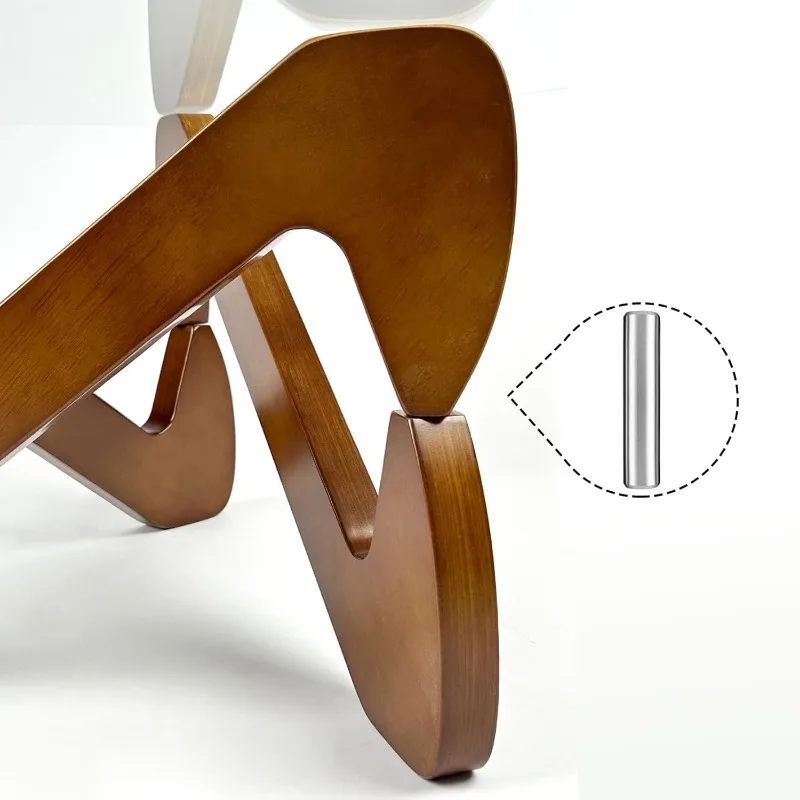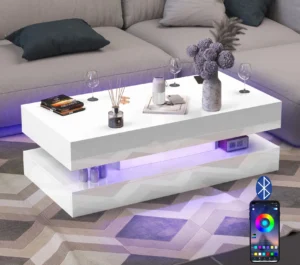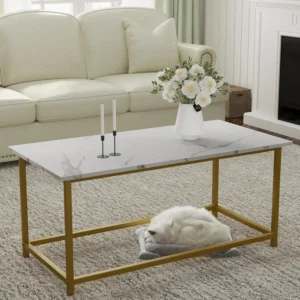Understanding the Appeal of Modern Glass Top Coffee Tables
Modern glass top coffee tables represent the perfect marriage of form and function in contemporary interior design. These striking pieces are defined by their clean lines, minimalist approach, and functional aesthetic that seamlessly blends into today’s living spaces. The evolution of glass tables has been remarkable – from their roots in mid-century modern design to becoming versatile centerpieces in contemporary homes.
Glass as a material choice for coffee tables has grown exponentially in popularity, and for good reason. The transparency creates a sense of visual lightness that can make even small spaces feel more open and airy. Unlike solid tables that can visually dominate a room, glass tables offer the unique ability to showcase the space rather than obstruct it.
This design approach draws heavily from influential movements like Bauhaus and Mid-Century Modernism, which championed the “less is more” philosophy. The enduring appeal of glass top coffee table ideas stems from their ability to adapt to nearly any design scheme while maintaining their distinctive modern character.
Key Materials That Define Modern Glass Coffee Table Designs
Glass Types and Finishes
The foundation of any glass coffee table begins with the glass itself. Modern designs typically feature tempered safety glass, which is heat-treated to be significantly stronger than standard glass. Beyond the basic clear glass, today’s options include:
- Clear tempered: The classic choice that maximizes transparency and light flow
- Frosted: Provides a soft, diffused appearance with semi-privacy
- Smoked: Adds depth and sophistication with gray to black tinting
- Colored: From subtle blue-green tints to bold hues for dramatic statements
Metal Frameworks
Metal elements create striking contrasts against the transparency of glass:
- Stainless steel: Offers sleek, contemporary lines with excellent durability
- Brass and gold-toned metals: Provides warmth and luxury
- Powder-coated steel: Available in virtually any color for customized aesthetics
- Chrome: Delivers a mirror-like reflective quality that enhances light
Wood Elements
Natural wood introduces organic warmth that balances the coolness of glass:
- Walnut: Rich, dark tones that create dramatic contrast
- Oak: Light to medium tones with distinctive grain patterns
- Teak: Golden hues that develop a beautiful patina over time
Alternative Materials
Innovative glass vs wood coffee tables aren’t the only options in modern design. Other materials that pair beautifully with glass include:
- Stone and marble: Creates a luxurious, substantial base
- Concrete: Offers industrial appeal with unexpected texture
- Acrylic/lucite: Enhances the floating, transparent quality
The most compelling mid-century modern glass top coffee tables often combine multiple materials—perhaps a walnut frame supporting a clear glass top, or a brass structure holding smoked glass—creating visual tension that makes these pieces so captivating.
Structural Forms and Silhouettes
The structural form of a modern glass coffee table plays a crucial role in defining its character and functionality. Contemporary designs embrace a variety of shapes, each offering different aesthetic and practical advantages:
Geometric Precision
Clean, geometric forms represent the cornerstone of modern design:
- Rectangular: The most versatile shape, aligning with standard sofa dimensions
- Square: Perfect for balanced seating arrangements or smaller spaces
- Round: Softens angular furniture arrangements and improves flow
- Oval: Combines the benefits of rectangular function with softened edges
Many mid-century modern round coffee tables feature perfectly circular tops that create a sense of harmony and balance in living spaces.
Abstract and Asymmetrical Designs
For those seeking statement pieces, asymmetrical and organic shapes break from convention while maintaining modern sensibilities. These designs often feature irregular curves or intentionally off-center elements that introduce visual intrigue.
Multi-Tiered Configurations
Modern glass tables frequently incorporate multiple levels, offering both aesthetic complexity and practical functionality. These designs might include:
- Floating lower shelves for storage
- Nesting components that can be reconfigured as needed
- Split-level surfaces that create visual dimension
Base Designs
The foundation of a glass coffee table significantly impacts its overall presence:
- Pedestal bases: Create a sculptural focal point
- Four-leg designs: Offer stable, architectural appeal
- Cantilevered structures: Generate a floating effect
- Sculptural supports: Transform the table into an artistic statement
The most successful designs maintain perfect proportions between components, often utilizing principles like the golden ratio to create visually satisfying balance.
Visual Elements That Enhance Modern Appeal
The distinctive appeal of glass coffee tables emerges from several key visual characteristics that separate them from their solid counterparts:
Transparency and Visual Lightness
The most defining feature of glass tables is their transparency, which creates:
- A sense of openness that expands visual space
- Unobstructed views of flooring, rugs, and other design elements
- The illusion of “floating” furniture that doesn’t weigh down a room
Edge Treatments and Details
The treatment of glass edges dramatically influences a table’s overall appearance:
- Beveled edges: Reflect light in interesting ways and add subtle dimension
- Polished straight edges: Create clean, contemporary lines
- Rounded corners: Soften the look while improving safety
- Layered edges: Add visual weight and complexity
Glass Thickness Considerations
The thickness of glass transforms its visual impact:
- Ultra-thin glass (8-10mm): Creates an ethereal, barely-there appearance
- Standard thickness (12-15mm): Balances visibility with substance
- Extra-thick glass (19mm+): Makes a bold statement and communicates quality
Visual Weight Distribution
The most interesting popular glass top coffee table designs carefully balance their visual components:
- Top-heavy designs draw attention to the glass itself
- Base-focused tables treat the glass as a showcase for structural elements below
- Balanced designs create harmony between all components
Perhaps most remarkably, glass coffee tables embrace negative space as an actual design feature, allowing the absence of material to become part of the aesthetic story.
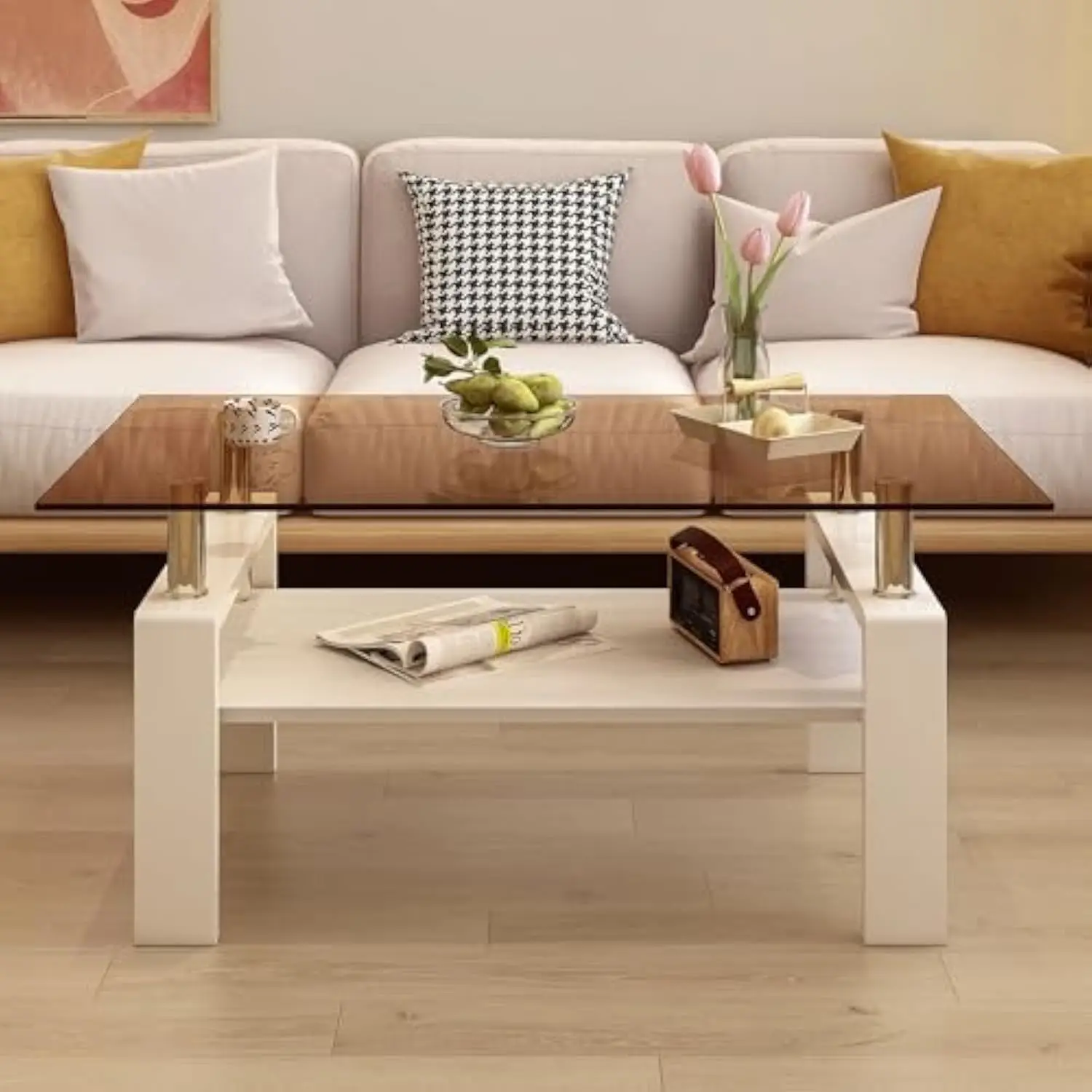
Functional Design Considerations
While aesthetics are important, the best modern glass coffee tables never sacrifice function for form. Several practical considerations ensure these pieces work as beautifully as they look:
Safety Features
Safety is paramount with glass furniture:
- Tempered safety glass: Designed to break into small, rounded pieces rather than dangerous shards
- Rounded corners and beveled edges: Minimize risk of injury
- Stable bases with proper weight distribution: Prevent tipping
Understanding glass coffee table safety tips is essential for households with children, pets, or high-traffic areas.
Storage Solutions
Modern glass tables often incorporate clever storage options:
- Visible lower shelves for decorative items
- Drawers integrated into base structures
- Magazine racks or compartments for remote controls
Size and Proportions
Functional glass tables maintain proper proportions relative to surrounding furniture:
- Height typically 1-2 inches lower than sofa seat height
- Width approximately two-thirds the length of the sofa
- Adequate clearance (18-24 inches) between table and seating
Many mid-century modern rectangular coffee tables follow these proportional guidelines while maintaining their distinctive aesthetic.
Surface Durability
Quality glass coffee tables address practical concerns:
- Scratch-resistant treatments for longevity
- Tempered glass for improved durability
- Easy-clean surfaces that resist fingerprints and smudges
The best designs anticipate real-world use while maintaining their visual appeal, striking the perfect balance between beauty and practicality.
How Different Glass Treatments Create Distinctive Moods
The type of glass selected dramatically influences the overall mood and impression of a coffee table:
Clear Glass
Clear glass maximizes transparency and:
– Creates a bright, open atmosphere
– Showcases the base design as the star of the show
– Visually recedes to make small spaces feel larger
– Reflects light to enhance room brightness
Frosted and Etched Glass
These treatments diffuse light and add texture:
– Create softer, more subdued lighting effects
– Offer partial privacy for items on lower shelves
– Add visual interest through patterns or gradients
– Reduce the visibility of fingerprints and dust
Smoked and Tinted Glass
Darker glass treatments introduce drama:
– Add sophistication and visual weight
– Create contrast against lighter room elements
– Filter light for a more intimate atmosphere
– Offer a contemporary edge to traditional spaces
Colored Glass
Bold color choices in glass transform tables into statement pieces:
– Introduce accent colors that complement the overall scheme
– Create focal points in neutral rooms
– Establish connections with other colored elements
– Add personality and unexpected visual interest
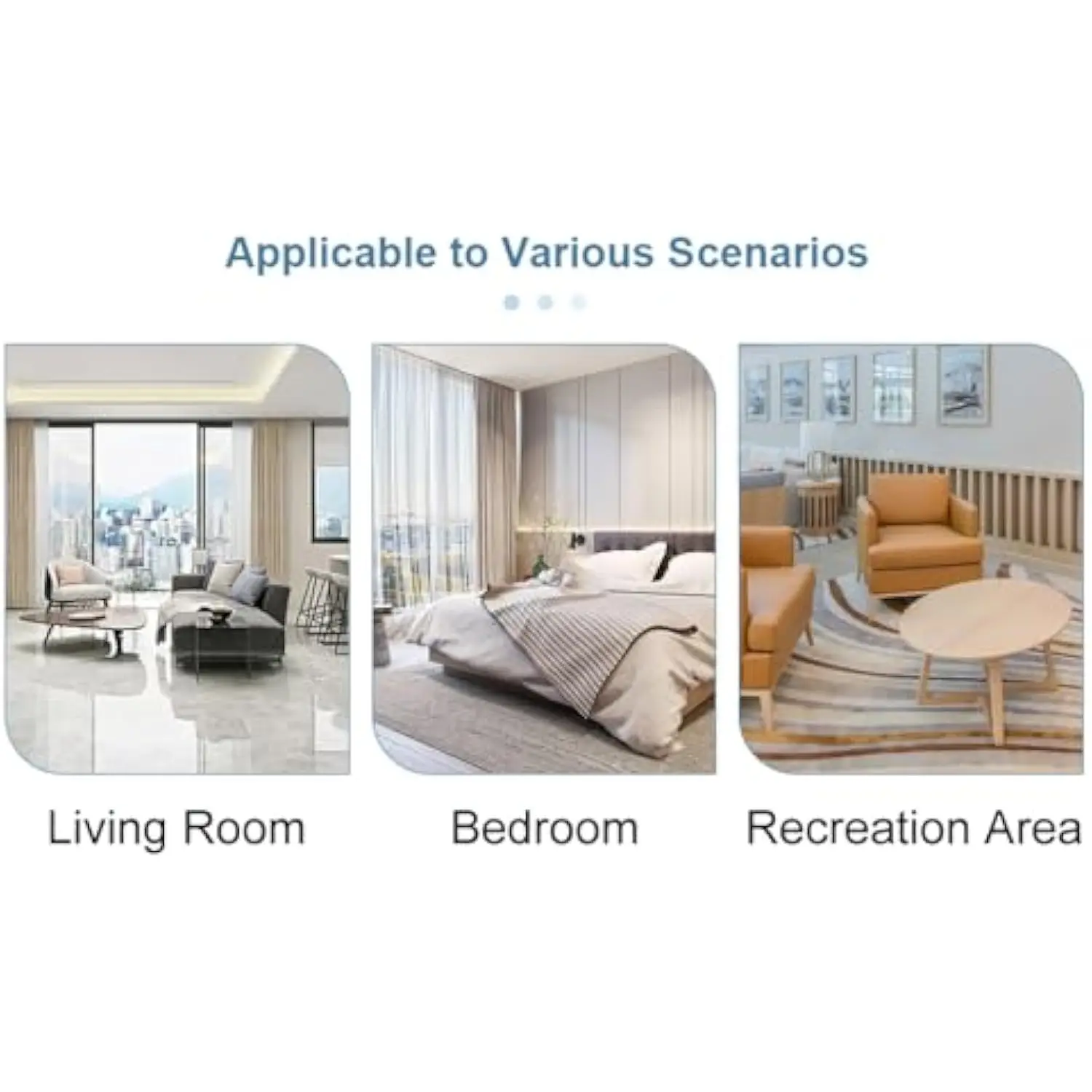
Complementary Design Elements for Modern Glass Coffee Tables
A glass coffee table doesn’t exist in isolation—it’s part of a cohesive design story. Creating harmony between your table and surrounding elements enhances the entire space:
Balancing Transparency and Solidity
The successful integration of glass tables relies on thoughtful balance:
- Pair glass tables with more substantial upholstered pieces
- Use visually heavy bases to anchor lightweight tops
- Contrast transparent surfaces with opaque decorative elements
- Layer textures to create visual interest
Effective Styling Approaches
Mastering styling glass top coffee table arrangements requires attention to:
- Height variation among decorative objects
- Grouping items in odd numbers for visual interest
- Using trays to corral smaller items
- Balancing hard objects (books, sculptures) with soft elements (plants, textiles)
Complementary Furniture Selection
Certain furniture pairings enhance the appeal of glass coffee tables:
- Low-profile sofas that don’t overwhelm the table’s delicate appearance
- Chairs with visible legs that continue the sense of openness
- Side tables that echo material elements from the coffee table
- Console tables that maintain consistent design language
Floor and Rug Considerations
The surface beneath a glass table significantly impacts its appearance:
– Textured rugs create interesting views through the glass
– Patterned carpets become part of the design composition
– Hard flooring materials provide stability and contrast
Understanding how Danish modern coffee table elements interact with glass components can further enhance your design scheme, creating a cohesive look that honors both traditions.
Current Trends in Modern Glass Coffee Table Design
Modern glass coffee table design continues to evolve, with several exciting trends reshaping contemporary offerings:
Mixed Material Compositions
Today’s most innovative designs fearlessly combine materials:
– Glass with natural stone for textural contrast
– Transparent tops with reclaimed wood bases for sustainable appeal
– Metal frameworks with glass inserts creating geometric patterns
– Combinations of clear and colored glass within single pieces
Sustainability Focus
Eco-conscious approaches are transforming glass table production:
– Recycled glass tops reducing environmental impact
– Sustainable wood sources for bases and frames
– Locally sourced materials reducing carbon footprint
– Designs emphasizing longevity over planned obsolescence
Integrated Technology
Forward-thinking designs incorporate practical technology:
– Built-in wireless charging pads
– Subtle LED lighting elements
– Temperature-controlled surfaces
– Smart-home compatible features
Glass coffee tables in style today often incorporate these technological elements while maintaining clean, uncluttered aesthetics.
Vintage Revival
Contemporary designers are revisiting classic forms with modern updates:
– 1970s-inspired smoked glass with updated proportions
– Mid-century silhouettes rendered in contemporary materials
– Traditional craftsmanship applied to modern forms
Many mid-century modern nesting coffee tables showcase this blend of nostalgic reference with contemporary function.
Mid-Century Modern Solid Wood Coffee Tables, Mid-Century Modern Teak Coffee Tables
$879.95 Select options This product has multiple variants. The options may be chosen on the product pageMid-Century Modern Danish Coffee Tables, Mid-Century Modern Oval Coffee Tables, Mid-Century Modern Solid Wood Coffee Tables
$390.05 Select options This product has multiple variants. The options may be chosen on the product pageMid-Century Modern Glass Top Coffee Tables, Mid-Century Modern Glass Top Side & End Tables
$460.58 Select options This product has multiple variants. The options may be chosen on the product pageMid-Century Modern Glass Top Coffee Tables, Mid-Century Modern Vintage Coffee Tables, Mid-Century Modern Vintage Side & End Tables
$725.36 Select options This product has multiple variants. The options may be chosen on the product pageMid-Century Modern Large Coffee Tables, Mid-Century Modern Rectangular Coffee Tables
$603.26 Select options This product has multiple variants. The options may be chosen on the product pageMid-Century Modern Marble Top Coffee Tables, Mid-Century Modern Rectangular Coffee Tables, Mid-Century Modern White Coffee Tables
Price range: $163.28 through $189.22 Select options This product has multiple variants. The options may be chosen on the product page
How to Select the Perfect Modern Glass Coffee Table for Your Space
Finding the ideal glass coffee table requires thoughtful consideration of both practical and aesthetic factors:
Assess Spatial Requirements
Begin with a clear understanding of your space:
– Measure available floor area, allowing 18-24 inches of clearance
– Consider traffic flow patterns around the table
– Note ceiling height and visual weight of other furniture
– Evaluate natural light sources that will interact with glass surfaces
Match Design Elements to Existing Décor
Ensure cohesion with your overall design scheme:
– Identify key materials already present in your space
– Determine whether your style leans toward minimalist, eclectic, or traditional
– Consider color schemes and how glass transparency might affect them
– Look for design elements that can be echoed in your table choice
Glass top mid-century coffee table layout tips can provide specific guidance for integrating these pieces into period-inspired settings.
Consider Lifestyle Needs
Practical concerns should inform your selection:
– Households with children might prefer rounded corners and extra-thick glass
– Pet owners might choose scratch-resistant finishes
– Frequent entertainers should prioritize adequate surface area
– Those who use their coffee tables as workspaces might select adjustable height options
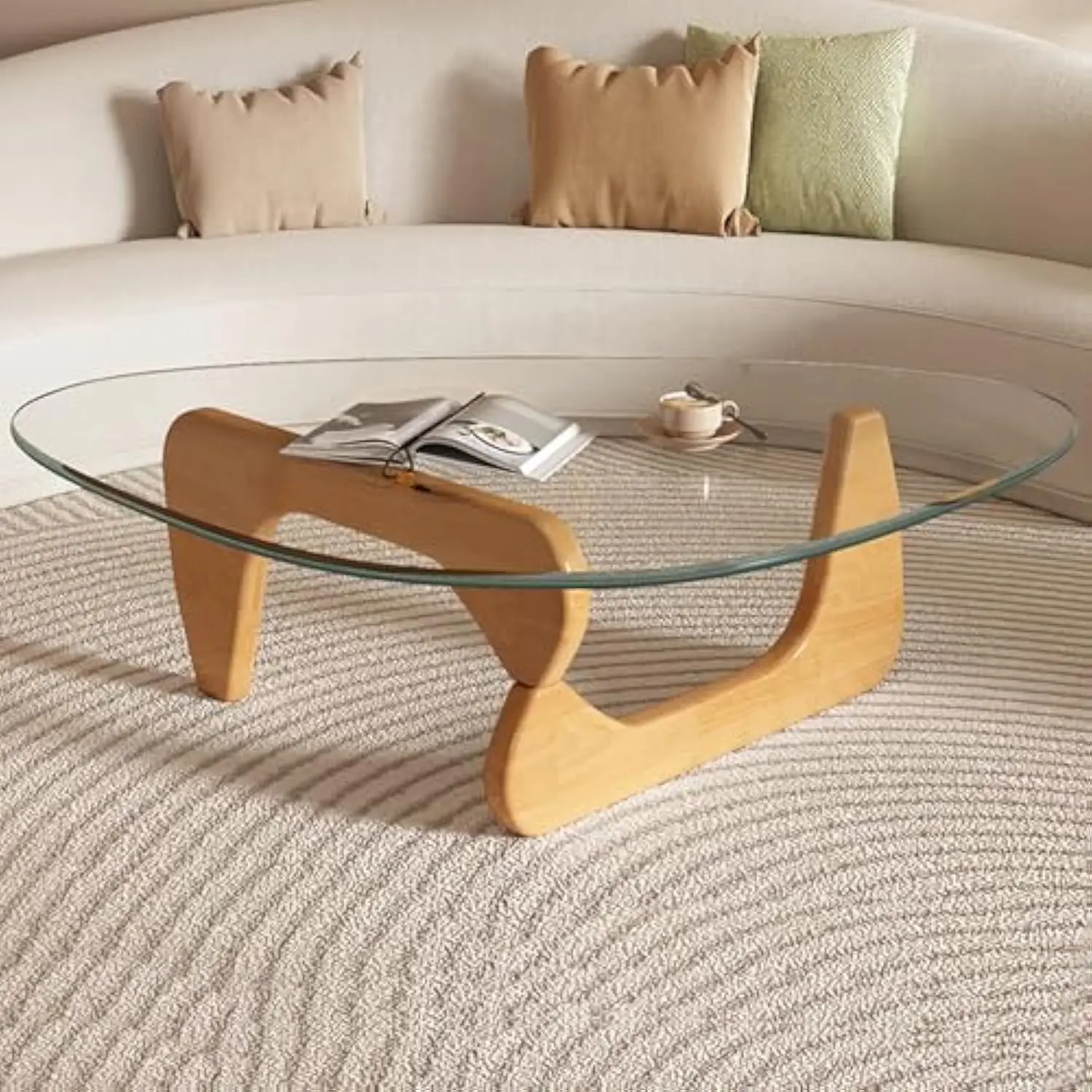
Is a Glass Top Coffee Table Right for Every Modern Interior?
While glass coffee tables offer numerous advantages, they aren’t universally ideal for all spaces. Understanding their limitations helps determine whether they’re right for your needs:
When Glass Tables Excel
Glass coffee tables particularly shine in:
– Smaller spaces where visual lightness prevents crowding
– Rooms with statement rugs that deserve to be showcased
– Design schemes emphasizing openness and flow
– Contemporary settings with complementary materials
When Alternatives Might Work Better
Some situations might call for different solutions:
– Homes with very young children where safety is the top priority
– Rustic or traditional interiors where glass might feel disconnected
– Spaces where frequent heavy use might challenge glass durability
– Rooms where other glass elements are already abundant
For those situations, mid-century modern solid wood coffee tables might provide more appropriate alternatives while maintaining modern design sensibilities.
Maintenance Considerations
Be realistic about maintenance requirements:
– Glass surfaces show fingerprints and dust more readily
– Regular cleaning is necessary to maintain transparency
– Specialty glass cleaners may be required
– Precautions must be taken to prevent scratches
The perfect coffee table ultimately aligns with both your aesthetic vision and practical lifestyle needs. Whether glass is the ideal material depends on finding that unique balance point where beauty and function intersect in your specific living environment.

